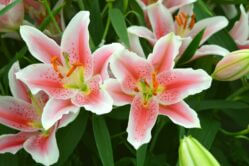Root-Drench Antitranspirant for Turf Grass and Sod
Root-Drench may prove to be at its most effective on monocotyledon plants. In one university test using palmer rye (sunny grass) and red fescue (shady grass) the grasses were irrigated with water or a water/Root-Drench solution. Then water was withheld for 20 days. After the 20 days normal watering was resumed, the grass that had been acclimated with Root-Drench was still green and turgid. The untreated control turned brown and did not survive the water shortage period. Field tests on a large variety of different grasses have shown similar results. Root zone is also effective in slowing turf plant growth, which should be an advantage in reducing mowing costs.
Substantially reducing water needs in the turf industry offers a variety of advantages to the grower and/or landscaper/greens keeper. Obviously, the cost savings is paramount, especially in areas where water is in short supply or expensive to obtain. Root-Drench can reduce these costs by as much as 40%. The grower or landscaper/greens superintendent should also factor in a savings in irrigation labor costs.
Because turf grass is so ineffective at managing available water the grower must irrigate with much more water than is actually needed. Unfortunately this creates an ideal habitat for mold and disease in both the thatch and the root system. By reducing excess water Root-Drench can minimize this problem.
Every grass maintenance professional has some areas that are hard to reach with normal irrigation systems. This usually results in dry edges that require hand watering. Root-Drench offers at least partial solutions to this problem.
Root-Drench is classified as a GRAS material and contains no phosphates, nitrates or petrochemical compounds which can cause ground water contamination. Root-Drench prolongs and improves turgidity and health during stress from digging, shipping and re-establishment of sod. Root-Drench is most effectively applied through normal irrigation methods. Root-Drench is also showing great promise for hydro seeders.
APPLICATION: Thoroughly water turf 24 hours prior to the application of Root-Drench. Root-Drench should be drenched into the turf using normal irrigation methods. Applying to wet soil is more effective than application to dry soil. Root-Drench should be mixed at a rate of 6 oz. per gallon of water to start. Apply Root-Drench solution at approximately at a rate of 2-3 gallons per 1000 sq feet. The primary objective is to establish a full root drench. After Root-Drench has been drenched into the turf a light application of water should be applied to carry the Root-Drench into the primary root area. This should also eliminate any possible surface residue, will produce the best results and will also clean you application system. If the a problem is severe it may require additional application or an increase in dilution strength. If the soil or thatch makes Root-Drench penetration difficult add a small amount of non-ionic surfactant to the Root-Drench mixture. Beneficial results may take a week or two to be noticeable.
APPLICATION:
Water turf 24 hours prior to the application of Root-Drench. Root-Drench should be drenched into the turf using normal irrigation methods. Applying to wet soil is more effective than application to dry soil. Root-Drench should be mixed at a rate of 3 oz. per gallon of water to start. Apply Root-Drench solution at approximately a rate of 2-3 gallons per 1000 sq feet. The primary objective is to establish a full root drench. After Root-Drench has been drenched into the turf a light application of water should be applied to carry the Root-Drench into the primary root area. This should also eliminate any possible surface residue, and will also clean you application system. If a problem is severe it may require additional applications or an increase in dilution strength. If the soil or thatch makes Root-Drench penetration difficult add a small amount of non-ionic surfactant to the Root-Drench mixture. Beneficial results may take a week or two to be noticeable.
RECOMMENDED TURF GRASS INITIAL TEST TRIALS:
Recommended dilution rates: 2-4-6-oz Root-Drench mixed into 1 gallon of water for test purposes only.
Trial Procedure in containers:
Place mature turf into 10 containers (flats) and allow plants to establish before treatments.
After establishment treat plants as described for potted plants, (See Root-Drench Preliminary Trials)
Trial Procedure for turf established in ground.
Identify an area of turf that is uniform and divide the area into 10 equal squares approximately 24″ per side and add a buffer zone at least 12″ between each of the squares. Mark the treated area with string to identify the squares easily.
Treat five squares at random with about a gallon of water.
Treat five squares at random with the Root-Drench mixture about one gallon per square.
Do not add any additional water on the treated area for several days depending on weather conditions and observe the plants for wilting, phytotoxicity and other symptoms worth noting.
You may want to photograph the above treatments for records.
When favorable results are achieved and the dilution rate is satisfactory, testing should no longer be necessary, unless there is a change in the plant or media status.
The above protocol is recommended for determining the optimum concentration of Root-Drench to apply for your turf to significantly reduce watering and improve the quality of your turf. If you have any questions in conducting these tests or in interpreting the result please contact us at GSI Horticultural.
CLEAN UP:
Because Root-Drench contains a large amount of polyhydric alcohol (a carbohydrate) it can remain sticky. Clean tools, irrigation lines and spray equipment with water after use.
WHERE ROOT-ZONE OFFERS GROWER BENEFITS
Reduce watering during periods of drought
Establishment of new turf-grass or sod
Shipping and transplanting of sod
Difficult soil conditions
Areas that are difficult to water
Areas that require ongoing high quality appearance.
POTENTIAL — USES
Golf tees, fairways and greens
Athletic fields
Commercial and industrial landscape areas
Highway medians
Residential lawns

